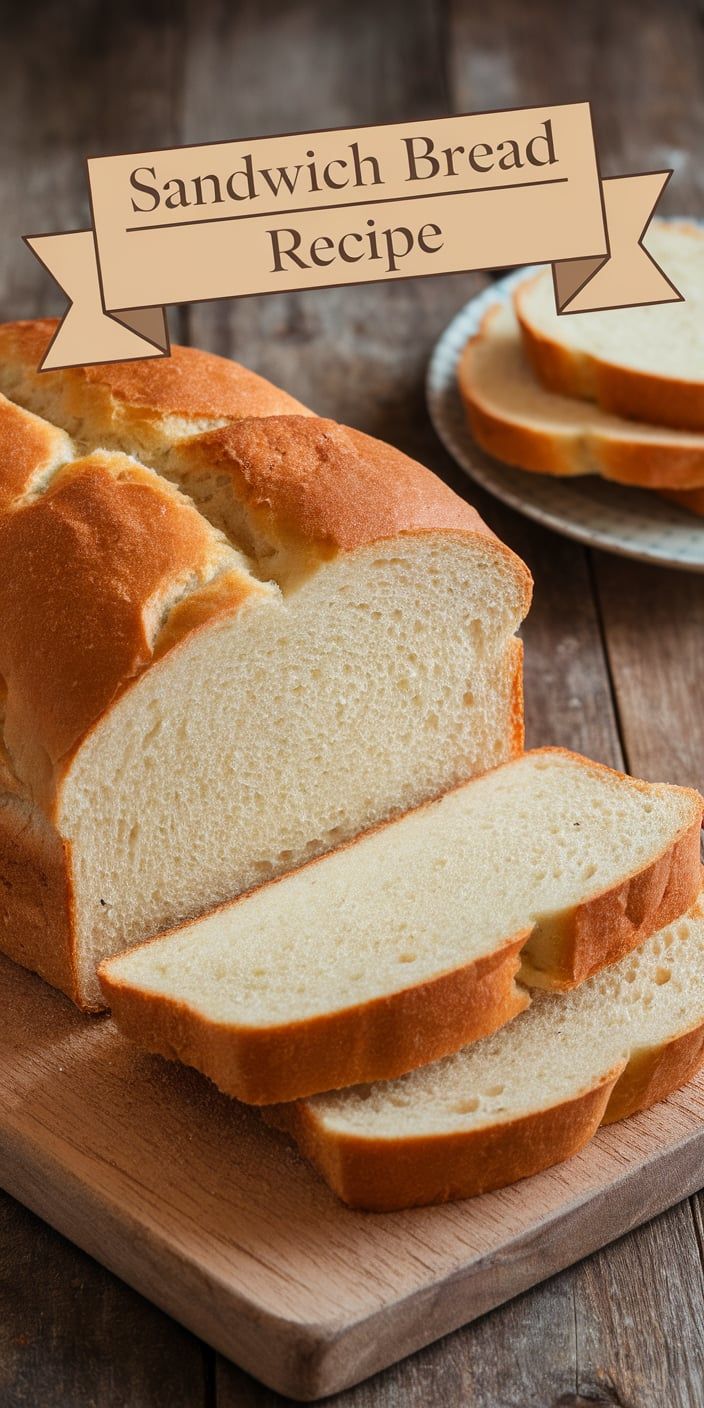Freshly baked homemade sandwich bread fills your kitchen with a wonderful smell. I love baking and have made a simple recipe. It turns basic ingredients into a soft, tasty loaf.
This bread recipe is more than just a guide. It’s a journey into traditional baking. It’s easy for beginners and experts alike to make great bread at home.
My method makes bread-making simple. You’ll make a soft loaf perfect for sandwiches or toast. You’ll love baking bread from scratch!
I’ll show you all you need to know. From picking ingredients to baking techniques. Soon, you’ll make delicious homemade sandwich bread that will wow everyone.

Why This Sandwich Bread Recipe Will Become Your Go-To
Making the best sandwich bread is more than mixing ingredients. It’s about mastering the art and science of making a perfect loaf. This journey has been both hard and rewarding for me.
The Secret Behind Its Perfect Texture
The magic of this bread is in its special preparation. I found that the right crumb comes from more than just a recipe. Important steps include:
- Precise flour hydration
- Gentle kneading methods
- Controlled proofing temperatures
What Makes This Recipe Different
This recipe is different from store-bought breads. It uses only pure, simple ingredients. The big differences are:
- No artificial additives
- Complete control over ingredient quality
- Customizable flavor profiles
Health Benefits of Homemade Bread
Baking homemade bread is more than just cooking. It’s a healthier choice. Homemade bread is more nutritious than commercial loaves. By choosing quality ingredients and avoiding chemicals, you make your meals healthier.
This leads to a delicious, wholesome bread. It makes every sandwich better and brings happiness to your kitchen.
Essential Ingredients for Classic Sandwich Bread
Making the perfect sandwich bread is all about the right ingredients. I’ll show you the key ingredients for a tasty loaf. These essentials will make your baking at home better.
- Flour: The base of any good bread. All-purpose flour is best for sandwich bread, giving it the right texture.
- Yeast: This magic ingredient makes bread rise and soft.
- Salt: It adds flavor and helps yeast grow.
- Sugar: It feeds yeast and adds a bit of sweetness.
- Water: It activates yeast and holds the dough together.
Using top-quality ingredients is key for the best results. The right mix of these essentials can make your homemade bread amazing.
| Ingredient | Purpose | Recommended Amount |
|---|---|---|
| All-Purpose Flour | Provides structure | 3-4 cups |
| Active Dry Yeast | Helps bread rise | 2 1/4 teaspoons |
| Salt | Enhances flavor | 1-2 teaspoons |
| Sugar | Feeds yeast | 1-2 tablespoons |
Need to make changes for dietary needs? No problem! Use whole wheat flour for a healthier loaf. Honey is a great sugar substitute for a natural sweetness.
Kitchen Tools and Equipment You’ll Need
Want to make tasty sandwich bread? You need the right tools. I’ll show you the key bread baking tools for success.
Having the right tools makes a big difference. They help you make perfect sandwich bread, no matter if you’re new or experienced.
Must-Have Baking Tools
- Loaf Pan: A 9×5 inch metal loaf pan is crucial for shaping your sandwich bread
- Large mixing bowl for combining ingredients
- Sturdy wooden spoon or silicone spatula
- Clean kitchen towel for covering dough during rising
- Wire cooling rack to prevent soggy bread bottoms
Optional but Helpful Equipment
- Stand mixer with dough hook attachment
- Bench scraper for easy dough handling
- Proofing basket for advanced bread making
- Instant-read thermometer to check bread internal temperature
- Pastry brush for egg wash or butter application
Measuring Tools for Accuracy
Precision is key in bread baking. Quality measuring tools are a must for consistent results:
- Digital kitchen scale for precise ingredient measurements
- Liquid and dry measuring cups
- Measuring spoons with clear markings
You don’t need every tool. Many can be replaced with what you already have.
Step-by-Step Sandwich Bread Recipe
Making sandwich bread at home is simple. I’ll show you a recipe for a soft, tasty loaf every time.
- Activate the Yeast: Mix lukewarm water, sugar, and yeast in a warm bowl. Wait 5-10 minutes for it to foam up.
- Mix Dry Ingredients: In another big bowl, mix flour, salt, and any extra dry stuff. Make a hole in the middle.
- Combine Wet and Dry Ingredients: Add the yeast mix to the flour. Mix in softened butter or oil. You’ll get a messy dough.
- Kneading Process: Put the dough on a floured area. Knead for 8-10 minutes until it’s smooth and bouncy.
- First Rise: Put the dough in a greased bowl, cover it with a wet cloth. Let it rise in a warm place for 60-90 minutes until it doubles.
- Shaping the Loaf: Punch down the dough, shape it into a rectangle. Put it in a greased bread pan.
- Second Rise: Cover it again and let it rise for 30-45 minutes.
- Baking: Heat the oven to 375°F. Bake for 30-35 minutes until it’s golden and sounds hollow.
Follow these steps to make a great homemade loaf. Remember, practice makes perfect. Don’t worry if it’s not perfect the first time!
Tips for Getting the Perfect Rise and Texture
To get the perfect bread, you need to know a few things. Making homemade sandwich bread that’s light and fluffy is all about the rising tips. It’s what makes it so delicious.
Understanding Yeast Activation
Yeast is what makes bread come to life. For the best texture, use fresh active dry yeast. Make sure the water is just right for activating it.
Water that’s too hot will kill the yeast. Water that’s too cold won’t make it work right. The perfect temperature is between 100-110°F.
- Use warm water (100-110°F)
- Add a pinch of sugar to feed the yeast
- Let the mixture sit for 5-10 minutes until foamy
Kneading Techniques for Beginners
Kneading is key for making bread soft and airy. As a beginner, aim for a dough that’s smooth and elastic. It should spring back when you press it gently.
- Knead for 8-10 minutes by hand
- Use the windowpane test to check gluten development
- Avoid adding too much flour during kneading
Temperature and Timing Guidelines
The right environment is crucial for bread rising. A warm, draft-free space is best. Bread usually takes 1-2 hours to rise, depending on the room’s temperature.
- Proof dough in a warm area (around 75-80°F)
- Cover dough with a damp cloth to prevent drying
- Let bread rise until it doubles in size
Common Mistakes to Avoid When Making Sandwich Bread
Learning to make sandwich bread takes time. Knowing common mistakes helps you bake better. I’ve found some key tips to make your bread turn out great.
Here are some big mistakes to watch out for:
- Yeast Activation Errors
- Using water that’s too hot or too cold
- Working with expired or inactive yeast
- Not allowing proper proofing time
- Dough Handling Mistakes
- Over-kneading or under-kneading the dough
- Insufficient rising time
- Incorrect room temperature during proofing
Temperature is very important in bread making. Use a kitchen thermometer to check your water. It should be between 100-110°F for yeast to work best.
Measuring ingredients correctly is also key. Digital scales help avoid mistakes. Baking is a science, and small changes can make a big difference.
If you’re having trouble, don’t worry. Just keep trying. Each time you bake, you learn something new. This helps you get better at making bread.
Storage Tips and Shelf Life
Storing homemade bread can be easy. For the first two to three days, keep it at room temperature. Use a bread box or paper bag for the right mix of moisture and air.
Refrigeration can help, but be careful. Cold air can dry out your bread. Freeze it for longer storage. Wrap in plastic wrap and then a freezer-safe bag to avoid freezer burn.
Want to make stale bread fresh again? Sprinkle it with water and warm it in the oven. This makes it soft and fresh-tasting. Always cool bread before storing to avoid moisture.
Don’t throw away leftover bread! It’s great for croutons, breadcrumbs, or bread pudding. Being creative with bread can save food and make your kitchen more efficient.
